
The rapid growth of social networks and e-commerce platforms has transformed the way people communicate and transact around the world. Integrating digital payments into these growing networks and platforms has presented vast opportunities to drive economic opportunity, financial inclusion, transparency, security, and growth.
In practically all countries individuals, businesses, and policymakers are recognizing these opportunities and acting on them, but perhaps nowhere more so than in China.
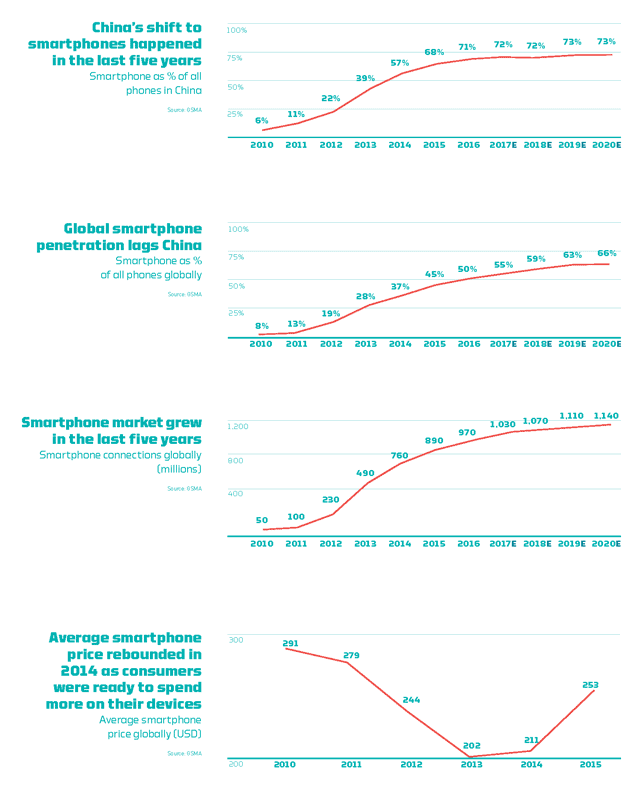
This report examines two of China’s most far-reaching applications – WeChat and Alipay – and explores their role in the development of one of the world’s largest and most sophisticated digital payments ecosystems.
China’s online payment market share
As China’s economy is unique, this report has also identified key factors in the successful integration of digital payments into social networks and payment platforms. In this way, the report aims to provide lessons that can be assessed, and where relevant, applied in other markets beyond China.
As social networks and e-commerce continue to grow and offer new opportunities as well as risks, the report adds to a body of knowledge about how digital payments can improve lives and strengthen economies in all parts of the world.
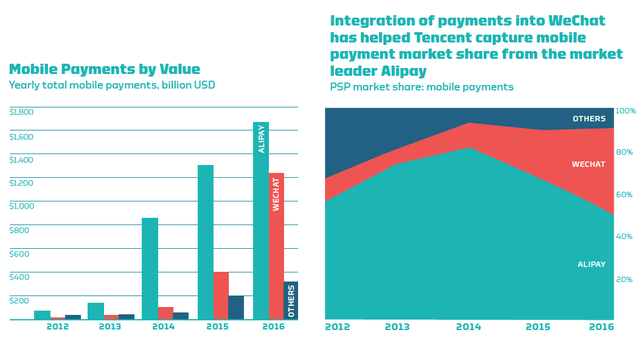
Combined Alipay and WeChat payments (by value) have risen from less than RMB 1 trillion (US$81 billion) in 2012 to an estimated RMB 20 trillion (US$2.9 trillion) in 2016 – a 20-fold increase in four years.
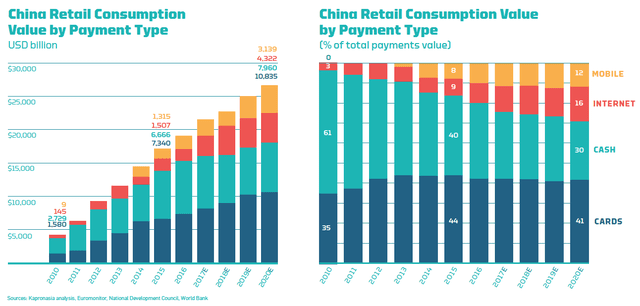
In 2015, non-cash payments accounted for nearly 60% of retail transactions in China. Of all non-cash payments, Alipay and WeChat Pay captured 28% of all retail transaction fees; effectively what would have
been nearly US$20 billion in payments fees on transactions had they been processed on traditional card payment networks. Digital payments as a whole have grown rapidly from about 3.5% of all retail transactions in China in 2010 to about 17% in 2015.
Digital payments as a whole have grown rapidly from about 3.5% of all retail transactions in China in 2010 to about 17% in 2015.
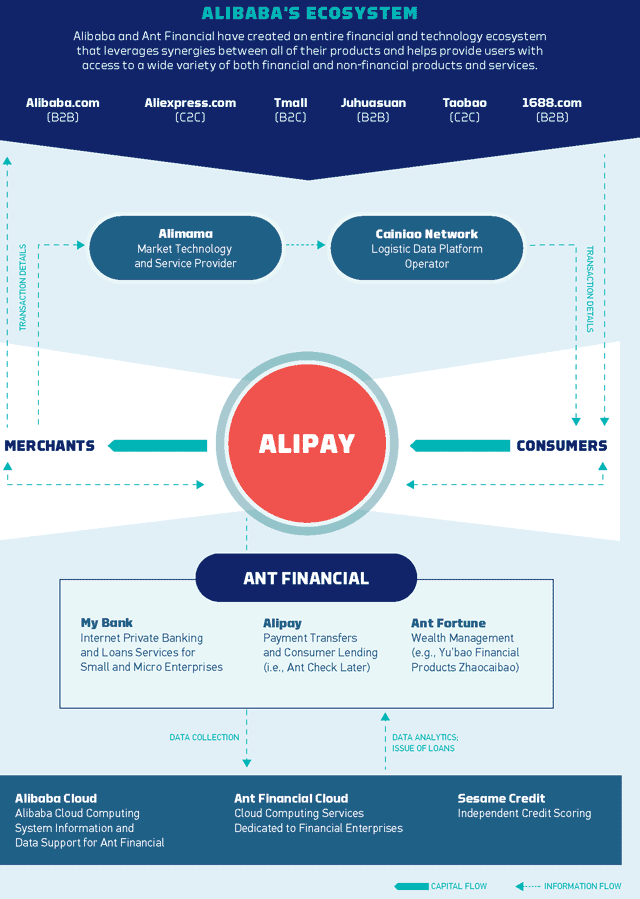
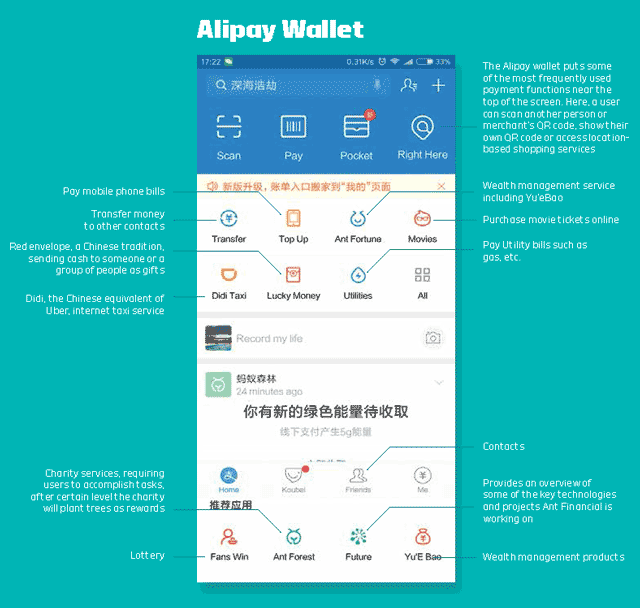
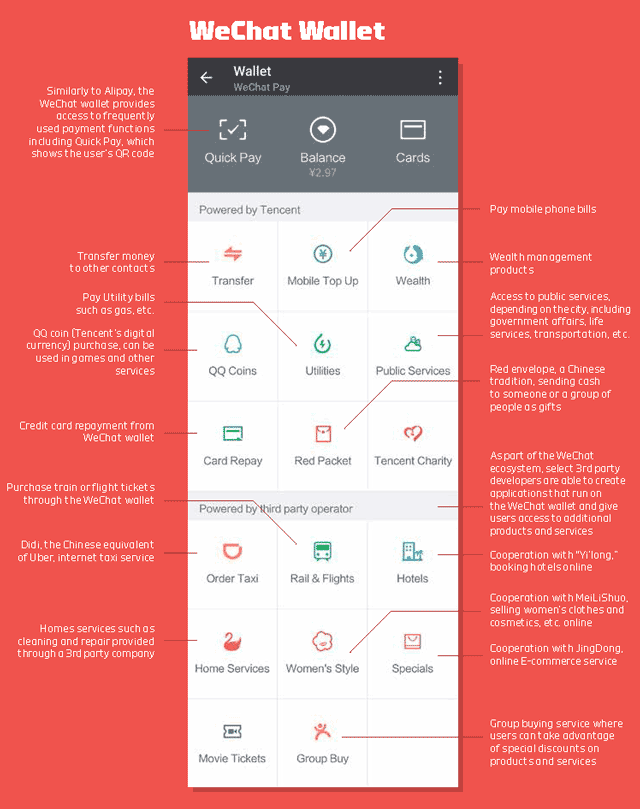
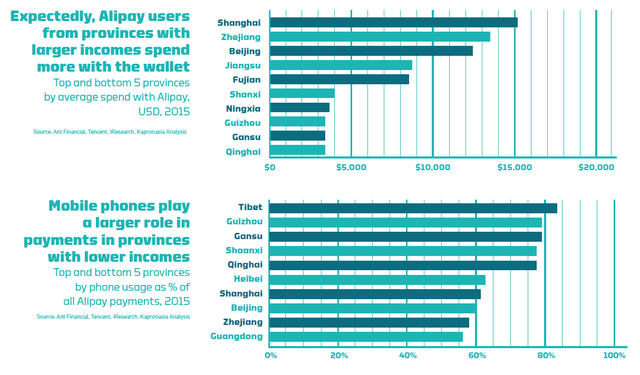
Key Findings
Significantly, the growth of digital payments using existing platforms and networks in China has brought with it a much wider range of digital financial services that are both expanding financial inclusion and economic opportunity for individuals and creating valuable new business models for companies.
1. New financial services have proven highly popular, delivering benefits to large numbers of people.
Alibaba worked with Tianhong Asset Management and launched the Yu’E Bao (meaning “leftover treasure”) product, a low-risk money market account similar to a bank savings account. Customers can take the money “left behind” on their digital wallets and invest it on the Yu’E Bao product.
While these services usually involve small individual amounts, they nonetheless provide benefits that can be helpful particularly for people living on low incomes. The scale of these individual savings products, when viewed in aggregate, is significant helping to explain how these products represent new business models that are attracting attention in countries around the world.
Yu’E Bao has grown from having 0.2 billion RMB (US$29 million) in assets under management (AUM) in 2013 to more than 810 billion RMB (US$117 billion), serving more than 152 million customers three years later and making it one of the largest money market funds in the world.
2. Digital finance has dramatically increased economic activity and e-commerce among merchants and consumers
As of September 2016, one provider, Ant Financial, had lent a total of RMB 740 billion (US$107.3 billion) to over 4.11 million small and micro enterprises and entrepreneurs. New business models enabling lending to people on low incomes are driving significant new usage of digital payments in a country where 79% of adults have had a bank account at some point, but only 10% of these have ever borrowed in the formal financial system.
For example, Huabei or “Just Spend,” is a service launched in 2014 which allows shoppers to take out small month-to-month loans. On Single’s Day 2016 (a major consumer-focused holiday similar to Valentine’s Day), consumers spent a total of RMB 26.8 billion (US$3.9 billion) using the Huabei service on two major e-commerce platforms.
3. Effective incentives and demonstrable utility are key factors in stimulating initial use and cultivating customer loyalty
For example, in 2014, Tencent launched its WeChat Red Envelope campaign – a digital version of an old Chinese custom of giving small amounts of money to friends and family in red envelopes during Chinese New Year.
In order to receive the red envelopes, the recipient was required to have a WeChat account that was connected to a bank account. Within the first week, more than 8 million people used the service, and the number of new bank accounts connected to WeChat surged by the millions.
During Chinese New Year 2017, WeChat users sent each other 46 billion digital red envelopes, an increase of 43% from 2016.
4. New credit scoring services are becoming available which are increasing access to credit, particularly for people on low incomes and small businesses.
One such service – Sesame Credit – is able to assess credit worthiness for over 350 million real-name registered users and 37 million small businesses that buy and sell on Alibaba Group marketplaces. When users sign up for Sesame Credit they agree to allow Ant Financial to use their transaction data to determine their credit score.
These credit-scoring services are increasingly being used outside of China in both the public and private sector. For example, a trial program was set up in June 2015 with the Luxembourg Government to allow credit scores to be used in place of bank records in securing a visa for the Schengen travel area in Europe.
5. The major digital payments providers are rapidly expanding beyond China and investing in new financial technology companies.
Users can now use Alipay and WeChat Pay in Thailand, one of the most popular destinations for Chinese tourists, to pay for goods and services in many stores.
Alibaba has made a significant investment in India’s PayTM and Tencent into India’s PayU, two of the largest digital payment providers in India. Tencent has also recently launched a joint-venture initiative in Africa, allowing for payment in South African Rand.
These and other experiences in China show there are clearly vast opportunities that other countries can harness by using existing e-commerce platforms and social networks as a foundation for expanding the digital payments ecosystem.
A 2016 report from the McKinsey Global Institute estimated that digital finance could add US$3.7 trillion to GDP across all emerging economies in aggregate by 2025, a 6% boost above the projected baseline, and create 95 million new jobs.
For China, it could mean an additional US$1.05 trillion (RMB 7.25 trillion), a 4.2% GDP boost above the projected baseline GDP for 2025. In China, that shift to digital – which is now well underway – would not have been possible without existing platforms and infrastructure.
Recommendations
For payment providers, e-commerce firms, and social networks
Attracting users by building on existing e-commerce platforms and social networks, using strategic incentives to deepen usage. For example, Tencent was able to build a widespread digital payment product within an existing service, which helped it gain rapid acceptance.
Major payment platforms in China have developed a variety of additional incentives for users, such as vendor promotions and discounts, and creative gamification concepts around popular cultural events.
Making platform tools openly available to innovators for seamless integration. For example, making software development tools, such as application program interfaces (APIs), available can enable third-party vendors and Small and Medium Enterprises (SMEs) to make their own innovative additions to the ecosystem in response to user needs and preferences, thereby organically growing the ecosystem.
Enabling universal access for users and businesses by developing ecosystems that function across various platforms. China’s two most popular payment apps are “hardware-agnostic,” in that both work across the Android and Apple iOS platforms, which combined, account for 99.3% of smartphone operating systems in urban areas.
This has helped to drive uptake and build out a large inclusive digital payments ecosystem. For payment providers, embracing interoperable platforms adds clear value for users and can help to grow a wider network of merchants and acceptance points.
For governments
Developing a supportive regulatory environment that strikes a careful balance between encouraging innovation and managing risk. In its efforts to strike a balance between these two objectives, China has announced policies to foster domestic development and competition, and support innovation.
The G20 High-Level principles also recognize the need to support innovation while managing risk and encouraging the development of digital financial products and services.
In China, the government has taken a “wait and see” approach to regulation which allows for innovation by industry participants within informal limits, under careful supervision by the relevant regulators. As products mature and their implications for users and the ecosystem emerge, the regulators develop the appropriate guidelines and rules to address these implications, protect consumers, and support a more cohesive payments ecosystem.
This approach of protecting and fostering domestic players may not be appropriate for every country, and each country should consider their own circumstances, but China does offer an illustrative example of how this strategy can work.
Setting public investment priorities that encourage digitization. This is particularly the case with the vital preconditions of digitization, such as effective infrastructure for the internet and mobile telecommunications.
In 2016, China had 530 million 4G users. This exceeds the number of 4G users in the United States and Europe combined. China expects to spend RMB 1.2 trillion (US$1.88 billion) over the next three years to further improve the quality of its broadband connectivity and mobile access. This will support the use of mobile smartphones – an important element in digital payments and digital finance usage.
For both businesses and governments
Encouraging public-private partnerships (PPPs) to develop an ID verification system or similar method to identify payers and payees accurately. Having a widely adopted and secure means of identifying customers is vital to enable secure and transparent payments and improve consumer protection.
It is also important in order to advance Know Your Customer (KYC), Anti-Money Laundering (AML), and Combating the Financing of Terrorism (CFT) efforts, and meet international standards in these areas. Governments and payment providers can work together to enhance adoption and use of identification.
Incorporating lessons of successful business models in payments over messaging platforms to drive adoption of digital payments in their own markets. As more examples emerge of companies successfully expanding their payments businesses internationally, there is a growing knowledge base that can reduce the trial-and-error component of building out inclusive digital payment ecosystems, particularly by anticipating key risks that have emerged in other countries and observing commercial and regulatory approaches that have proven effective.
China’s tech giants (particularly Tencent and Ant Financial) are rapidly expanding internationally, PayPal continues to grow its global footprint, and companies like Facebook are pushing into international payments, heralding a period of rapid international expansion of payment platforms. As these companies expand, national or regional players can both observe and incorporate their experiences, or partner with them to drive their own transitions to digital payments.
A key overarching issue in payments (both traditional and digital) is trust and convenience. There must be trust in the community or network (i.e., between the payor and payee), trust in the security of the payment mechanism, trust in the regulatory environment for consumer protection and recourse, and a belief that the method is beneficial. An examination of the China experience demonstrates that robust digital payments ecosystems can address all of these concerns and are, therefore, a useful way to accelerate the acceptance and use of digital payments. Despite the benefits, there are challenges.
An examination of the China experience demonstrates that robust digital payments ecosystems can address all of these concerns and are, therefore, a useful way to accelerate the acceptance and use of digital payments. Despite the benefits, there are challenges.
Regulators are still figuring out the right balance between innovation and regulation. China’s financial institutions are still working out their fintech strategies. Alipay and Tencent are expanding faster than many other similarly sized global tech companies. And we are still very much in the early days of fintech both inside and outside China. How this all plays out remains to be seen, but the initial impact of digital finance on China is difficult to over-exaggerate.
There are significant benefits of convenience and utility to be achieved by integrating payments functionality in existing e-commerce platforms and social networks. But even greater benefits of financial inclusion can be reached when robust digital payment ecosystems are developed around those networks and platforms. As China’s experiences
How this all plays out remains to be seen, but the initial impact of digital finance on China is difficult to over-exaggerate. There are significant benefits of convenience and utility to be achieved by integrating payments functionality in existing e-commerce platforms and social networks. But even greater benefits of financial inclusion can be reached when robust digital payment ecosystems are developed around those networks and platforms. As China’s experiences
But even greater benefits of financial inclusion can be reached when robust digital payment ecosystems are developed around those networks and platforms. As China’s experiences illustrate, being able to access vital financial services in an easy and convenient way increases the likelihood of their use. Digital payments ecosystems, therefore, can be a powerful catalyst to accelerate digitization and increase financial inclusion.
This report was originally published on BetterThanCash.org.